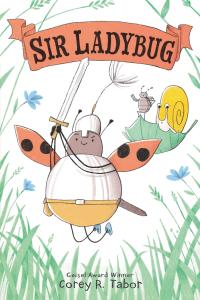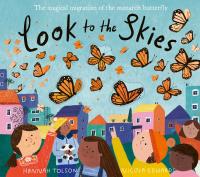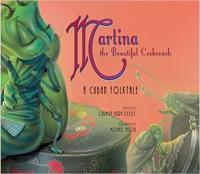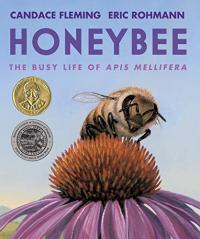
In the pages of this book, you’ll find a workshop filled with everything you need, including a head, a thorax, an abdomen, and much more. Written by an entomologist and accompanied by delightfully detailed illustrations, this wonderfully original take on insect anatomy will spark curiosity and engage even those who didn’t think they liked creepy, crawly things!
How to Build an Insect

Become a keen nature observer: an observologist! Cartoon-like illustrations and open text resemble a journal, inviting readers to look closely at the small things around them.
The Observologist

Handsome graphics accompany crisp text in this thorough exploration of insects, their sizes, and fascinating facts about them. The suggestions on what to do to protect insects are doable. Additional resources and an author’s note are included.
Insectorama: The Marvelous World of Insects

Imagination and science combine in gloriously detailed illustrations and descriptive poems for a unique look at what various creatures call home. Additional information about the animals and other resources conclude this memorable book.
Home

Humans could learn a great deal from ants and in fact share many things with humans. They live in families, have different jobs, and do better when they work together. Humorous (bug-eyed) ants and lighthearted text introduce these fascinating critters.
The Wonderful Wisdom of Ants

Lola and her mother visit Zora, a beekeeper, where Lola learns about bees and the work of a beekeeper. Lola then decides to plant seeds at home to help bees, in this informative addition to the series.
Lola Meets the Bees

A rhyming text and detailed illustrations combine to reveal bees’ activity, culminating in a large gatefold to reveal a lush garden. Backmatter provides information about types of bees and their role in pollination.
It Starts with a Bee

Poetry, photography, and information combine to present a range of fascinating creatures. Though rhymes can feel a bit forced, the combination is a unique introduction to a range of bees, bugs, and other things that crawl and skitter. By the same creative team: Bugs: Exploring the World of Crawly Critters.
Bees: Honeybees, Bumblebees, and More

What would your world look like if you were as small as a bean? Find out from the perspective of Jumper, a small spider that is both prey and hunter. Lush, realistic watercolor illustrations accompanied by engaging and informative text. Fascinating back matter and additional resources conclude this handsome volume.
Jumper: A Day in the Life of a Backyard Jumping Spider

Why do beekeepers use smoke machines when collecting honey? Can a bee really sting only once? Why do bees “dance”? Get an introduction to the life cycle, social organization, and history of one of the world’s most useful insects. Learn how bees make honey, what a beekeeper does, and products that contain beeswax — everything from lipstick to waxes for buffing surfboards.
The Life and Times of the Honeybee

Ever since he was a wee mite (a termite, that is), Roberto has wanted to be an architect. Discouraged by his wood-eating family and friends, he decides to follow his dream to the big, bug city. There he meets a slew of not-so-creepy, crawly characters who spark in him the courage to build a community for them all.
Roberto, The Insect Architect

The story of Charles Henry Turner, the first Black entomologist — a scientist who studies bugs. Can spiders learn? How do ants find their way home? Can bugs see color? All of these questions buzzed endlessly in Charles Henry Turner’s mind. He was fascinated by plants and animals and bugs. And even when he faced racial prejudice, Turner did not stop wondering. He constantly read, researched, and experimented.
Buzzing with Questions: The Inquisitive Mind of Charles Henry Turner

When a young and very hungry chickadee wants to eat a caterpillar, Sir Ladybug must cook up a delicious alternative. This easier to read graphic book is humorously illustrated and broken into chapters by a Caldecott honor winning creator.
Sir Ladybug

Look up! Can you see the gold and black butterflies migrating to warmer climes? The rhyming narration and colorful illustrations with die cuts effectively focus readers on monarchs. A brief note discusses the monarchs’ travel.
Look to the Skies

When a child realizes the small spider she finds in her room may be just as frightened of her as she is of it, rather than stomp it, she carefully moves it. Even the youngest spider-saver (or phobic) will appreciate the textured collage illustrations while building empathy.
Awake

A sweet and witty retelling of the Cuban folktale. Martina the beautiful cockroach doesn’t know coffee beans about love and marriage. That’s where her Cuban family comes in. While some of the Cucarachas offer her gifts to make her more attractive, only Abuela, her grandmother, gives her something really useful: un consejo increíble, some shocking advice.
Martina the Beautiful Cockroach

This story is “that of honey bees, CLAN APIS.” Nyuki is the newest honeybee in the hive and full of questions. Readers will delight in the handsomely illustrated story as well as learn a great deal about clan apis, how they live and work. Any remaining questions are likely answered in the extensive backmatter. Interestingly, the author is a biology professor who is also a cartoonist.
The Way of the Hive: A Honey Bee’s Story

Have you ever had one thought lead to another one that is seemingly unrelated? Open this unique book and readers will be able to follow trails from one thought to another, all playfully illustrated. Just right for browsing, the factoids contain nuggets to amaze and delight.
Factopia! Follow the Trail of 400 Facts

Make getting ready for bed an adventure with familiar creatures as young children try to guess who (or what) they will find. With a lift of each sturdy flap, the hidden answers are found.
Sleep Tight Very Hungry Caterpillar

Apis Mellifera, the worker honeybee, does a lot during its short life. Poetic language and highly detailed illustrations provide an up-close look at the bee, its hive, and expansive travels, cleverly seen in a double gatefold. Backmatter and further reading conclude this stunning book.
Honeybee: The Busy Life of Apis Mellifera

When you can’t stop moving, we say you have “ants in your pants.” That’s because ants always are moving! Fascinating facts are presented in a generously illustrated, humorous but factual format — including what ants eat and what eats ants. This is a worthy addition to the author’s fascinating and accessible series.
Ants Don’t Wear Pants

Explore nature from tiny seeds to ocean life, from worlds hidden underground to a frosted earth. Brief, lyrical text is illustrated on the opposite side of the open book which then folds out to provide additional illustrations and information about the scene. Colorful, stylized illustrations and die cuts add interest to each informative double-page spread.
A Walk Through Nature

Who lives in a pond? There are fish and fowl, insects and plants. Some live in the water, others near it. Straightforward questions are asked and answered as each is identified. Simple illustrations on sturdy, non-glossy pages made from recycled material are used in this and in the author/illustrator’s My Little Ocean (opens in a new window) to provide a quick way to introduce environments and words to young children.
My Little Pond

The story of one Lepidoptera as it evolved in England is a story of “change and adaptation, of survival and hope…[that] starts with a little moth.” Lyrical narration is accompanied by stunning but simple illustration in dark, dramatic hues and bold forms that chronicle the evolution of the Peppered Moth. A brief afterward discusses basic ideas of natural selection.
